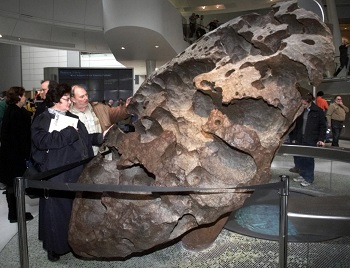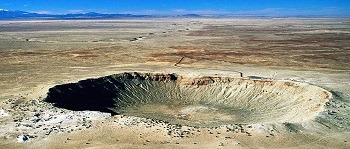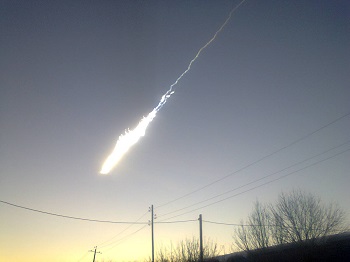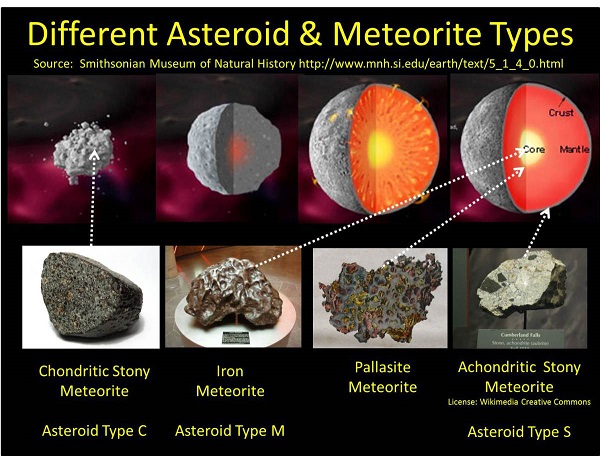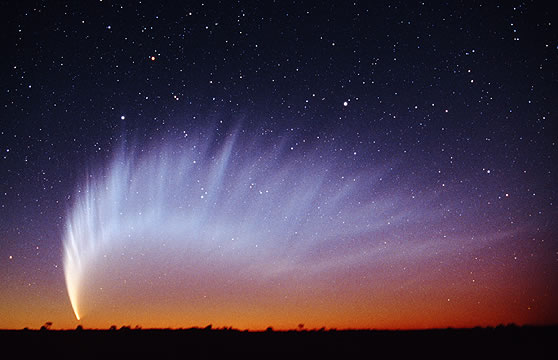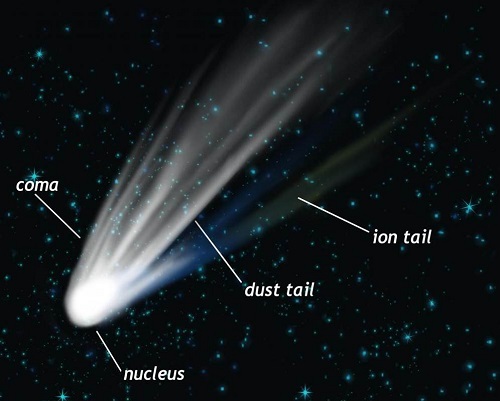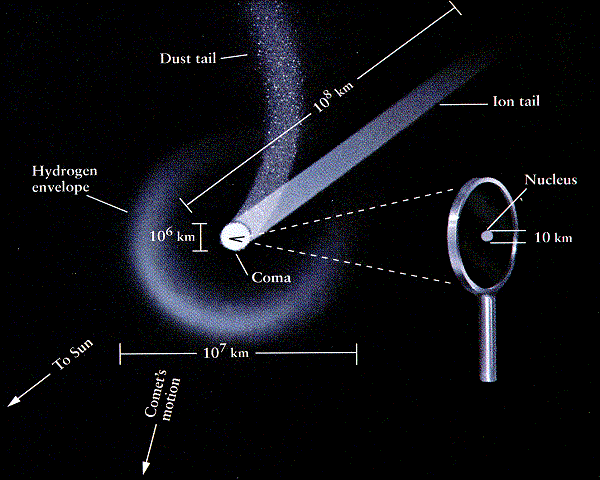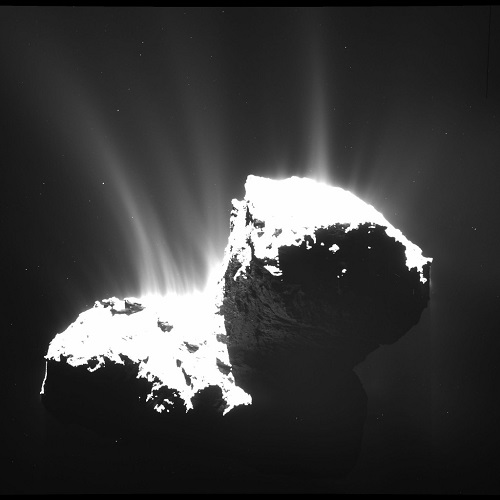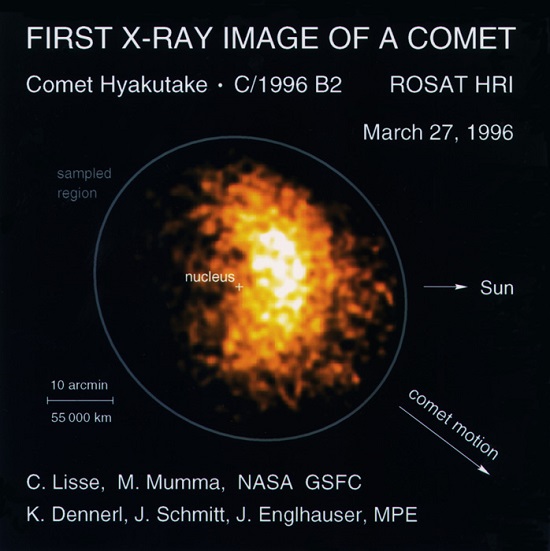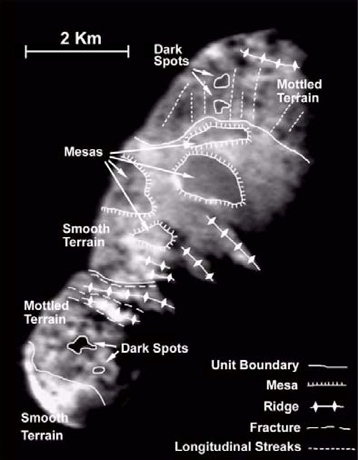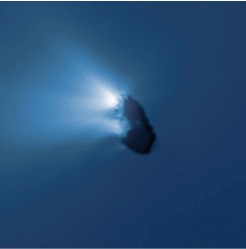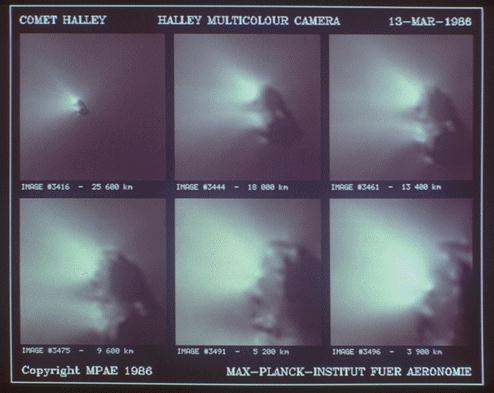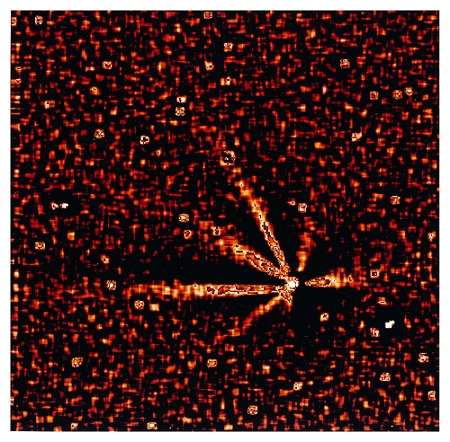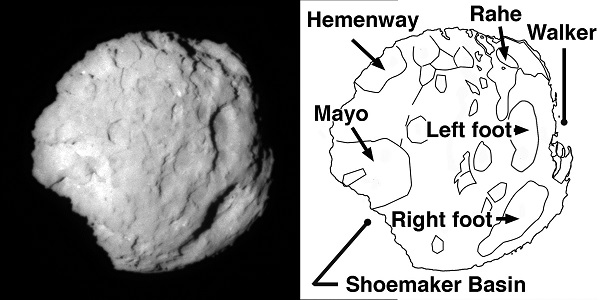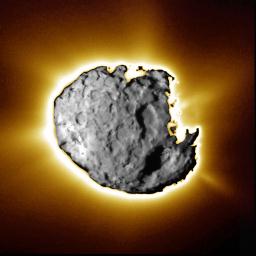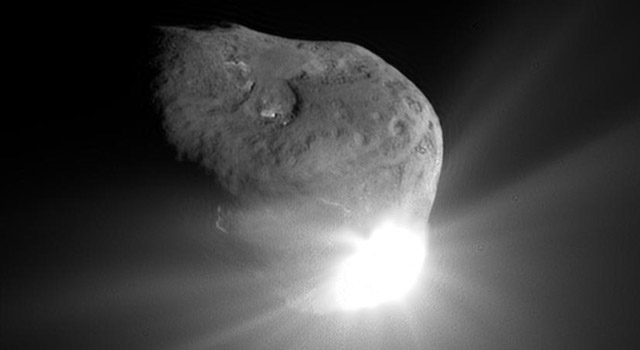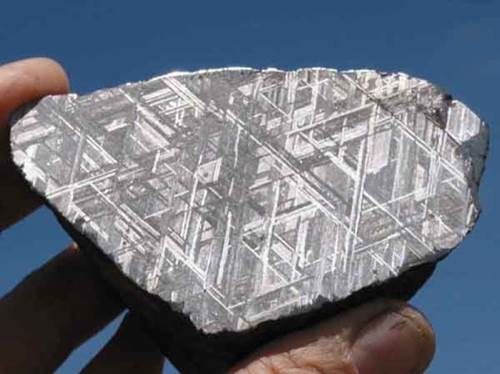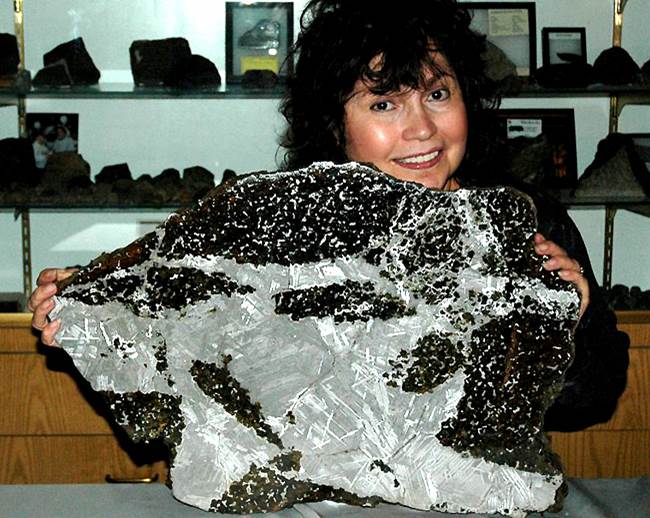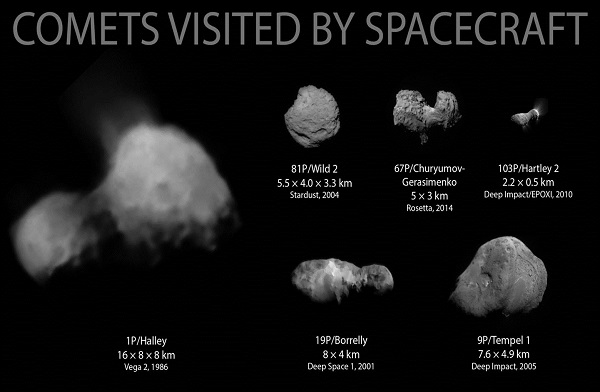|
Things That Fly Through the Skywell, not really the "sky" -- but it was a fun title Comets and Meteors and a little more on Asteroids
Definitions: Most people mix up what the differences are among asteroids, comets, meteors and meteorites. First of all, if it lands, no matter what it started out to be, it is a METEORITE. Look at the "it" in the last part of the word and think "IT lands!" The larger ones will leave craters if they hit the land. The largest ones have left craters even in the oceans.
A METEOR, no matter what its origin, is something we often call a 'falling star.' It is a bit of something coming through our atmosphere and burning up as it goes. If a part of it makes it through the atmosphere and lands, that's a meteorite.
An ASTEROID is a large rocky body in orbit around the sun. Some of the largest are called dwarf planets, such as Ceres. Asteroids are associated with the Asteroid Belt between Mars and Jupiter or having originated there. This would include the Trojans, which travel in Jupiter's orbit and the Apollos and Amor groups and the Aten group. These are discussed in the section on the Asteroid Belt. A much smaller particle in orbit around the sun is called a METEOROID. A COMET is an object which originates in the outer solar system which swings around the sun and then back out again. They are known by their 'tails' and the comas around their main bodies. Those that come within our line of vision are quite impressive.
Meteorites Because most meteorites are either iron, stony-iron, or stone, it appears they come from the same material that makes up the asteroids. There are times in the Earth's history when large amounts of impacts have happened in a very short time. When an asteroid actually hits the Earth (becoming a large meteorite), it often brings with it a cloud of debris which hits as well, leaving associated craters. This large an impact is a rare occurrence. The largest of these events are associated, geologically, with several occasions of mass extinctions. For more information regarding these events, please see the "The Geological Significance of CRE Ages" in "A Brief Stellar History."
As the above illustrations indicates, there is a good reason to suspect that there used to be a planet and its moon between Mars and Jupiter which was shattered, giving rise to the Asteroid Belt and many of the meteorites we find on Earth. (Note: in the above illustration, the Pallasite type is the stony-iron type). Many astronomers believe that fragments of comets have also made it through our atmosphere and impacted as meteorites. In his article, "Meteorites from Comets? Recent Observational Developments," Humberto Campins states
Meteors We mostly associate meteors which what we call "falling stars" -- the bright streaks across the sky which appear and disappear very quickly. Normally, meteors are actually just pieces of dust or tiny pea-sizes objects that burn up going through our atmosphere. Something as large as the one which exploded over Russia in 2013 is rare. What we see when we look up at that streak of light is the small object as it burns up. We see meteors in two ways: sporadic and showers. Sporadic meteors occur all the time but not in dramatic bunches. They appear singly at any time of year. Meteor showers, on the other hand, are predictable because they occur specific times in our orbit as we pass through a debris cloud left by a comet. The Perseid Meteor Shower occurs on or about August 12. The debris which causes that meteor shower is from the comet Swift-Tuttle. The Leonids occur around mid-November, and are the debris associated with comet Tempel-Tuttle. Interestingly, the Leonid Shower may deposit 12 or 13 tons of particles on Earth's surface each time we go through this cloud of particles -- something like dust drifting down from the sky. There are other, more minor meteor showers during the year, but the Perseids and the Leonids are the most dramatic. Of the two, it is the Leonids which have provided the most incredible displays in some years. For instance, in 1833, over 100,000 meteors per hour were viewed for about nine hours. Below is one of the illustrations of what people saw that night:
What can be seen in the above photograph is the direction from which the meteors are coming as the Earth spins on its axis. They all appear to come from the direction of the constellation of Leo, which is why they are called Leonids. Actually, however, they are not coming from any distant stars or star group. They simply appear that way because of the time of year we are in when we pass through this debris belt. The best time to see any meteor shower is about one in the morning (early morning!) due to the rotation of the Earth on its axis. In the early morning we are actually running into the meteors. Earlier in the evening they are trying to 'catch up' with us. Comets These dramatic heavenly sights are not nearly as common as meteors. That is because they originate from the outer solar system, come swinging toward the sun, orbit around it, and then go swinging back out again. This means that the time for one orbit of one comet can be in the hundreds or even thousands of years.
They are much larger than the bits and pieces they leave behind, some of which become the meteors we see in the showers. Comets range in diameter from about half a mile to about ten miles across -- that is the solid chunk in the center. That central piece is called the nucleus. What we see when they approach close enough to be seen, however, is not the nucleus. We see the shining coma (the Greek word for "hair," and the word from which "comet" is derived). The coma is made up of gases and dust which have come from the solid body of the comet itself. The coma dwarfs the tiny nucleus, and may be 50,000 miles across or more. The nucleus and the coma together are referred to as the "head" of the comet. We also see the "tail," a trail of gas and dust it leaves behind. Comet tails are divided, and we can often see that. The dust tail and the gas tail are different. The gas tail is a plasma tail, comprised of ionized gases, usually appearing bluish. The dust tail often appears white. The sun's radition pressure and the solar wind accelerate materials away from the comet's head at differing velocities, according to the size and mass of the materials. Relatively massive dust tails are accelerated slowly and so tend to be curved, following the orbit of the head itself. the ion tail is much less massive, and is accelerated so greatly that it appears as a nearly straight line extending away from the comet, and opposite the sun. These two tails can occasionally converge or appear quite spread apart, depending on the angle of our view. Both the plasma and dust tails may stretch out 50 million miles or more behind the comet head. . What we don't see, but which was picked up by spacecraft is a hydrogen 'envelope which surrounds the head of the comet. It is the material in these jets, forced back by the pressure of the sunlight and the solar wind, which forms the tails.
When the Pioneer Venus spacecraft was directed to examine Halley's Comet in 1986, it found that the hydrogen cloud surrounding it had grown as large as 12.5million miles wide. At fifteen times larger than the sun, this made it the largest structure in the solar system at that time. In the last thirty years, something else was seen: there were jets of gas and dust coming from the nucleus, quite apart from from tail.
Another surprise was awaiting astronomers. As they watched, pieces appeared to come off some of the comets, in an event referred to as comet splitting. Some photographs have been able to show this in motion. The possible causes are discussed in "Explanations and Interpretations." Originally, comets were considered to be "dirty snowballs" or "dusty icebergs." However, recent data from spacecraft calls into question some of this. Observation #1: Comets are X-ray emitters. No one expected comet Hyakutake to be a powerful source of x-rays. "Astronomers using ROSAT (the European Space Agency's Roentgen satellite) decided to look at Hyakutake and they were shocked by what they saw. ROSAT images revealed a crescent-shaped region of X-ray emission around the comet 1000 times more intense than anyone had predicted." Dr. Michael J. Mumma wrote, "We had no clear expectation that comets [would] shine in X-rays." The X-rays were as intense as those ROSAT usually picks up from bright X-ray stars and they flickeed like a fluorescent tube on a time scale of hours.
Observation #2: A comet's ion tail is 4 AU long even when distant from the sun. In May of 1996, the Ulysses spacecraft, which is studying the sun, surprised scientists when it went through the ion tail of Comet Hyakutake. The comet was then out past Jupiter, and our spacecraft was 360 million miles beyond that. They did not expect the tail of Hyakutake to be there. Observation #3: Speaking of Comet Hyakutke...it contained quite a surprise when astronomers were checking for various gases associated with it. They found a gas they did not expect at all -- ethane. Ethane is a complex hydrocarbon and not expected to be associated with comets. But it was there is much higher amounts than the expected gases. This had led astronomers to conclude there are different types of comets. Observation #4: Comets show complex terrain and exceptionally dark surfaces. They are not simply dirty ice balls. Astronomers feel that the pictures of the 10 km (6 mile) wide core of Comet Borrelly wiill revolutionize our understanding of comets. The spacecraft DS1 (Deep Space 1)passed within 1200 miles of thecomet's core in September of 2001. Here is what it saw:
Borelly shows rugged terrain, smooth rolling plains, deep fractures,and some very dark material. Halley's Comet showed the same sort of surprises. It's nucleus is about 10 x 5 x 5 miles large. Contrary to prior expectations,Halley's nucleus is very dark -- darker than coal or black velvet. This makes it one of the darkest objects inthe solar system. Its very low density means it is probably porous. Cameras almost missed Halley's nucleus because of its unexpected darkness. Astronomers expected the comet's nucleus to be made of bright, reflective ices. The bright spot they saw, however, was a bright geyser of escaping material.
Observation #5: Comets exhibit odd orbital behavior not associated with gravitational forces. Comets were expected to follow a smooth curve in their orbits, a curve mathematically predicted by gravitational forces. However, what was seen, were some erratic deviations from that curve. Some of those deviations could be explained by the action of the jets from the nucleus pushing the comet around. Some of the deviations do not seem to be explainable that way, however. Shown below are pictures of the first jets we saw from a comet nucleus. In March of 1986 this series of pictures was taken of Comet Halley which could certainly help explain some of the erratic motions of comets in their orbits:
Observation #6: Jets on comets are not due to heating. First of all, remember that jets from the nuclei were a surprise. When they were first spotted on Halley's Comet, it was found they were made up of water vapor, carbon dioxide, and carbon monoxide. Because of the composition of these ices, the conclusion was reached that the interior of Halley's must be about 35 degrees above absolute zero. That's -397 F. What astronomers expected was that as the comet neared the sun, the ices would be sublimated and turn directly to gas due to the sun's heat. The problem was that in 1991, Comet Halley flared up between the orbits of Saturn and Uranus -- much too far from the sun for heat to cause that reaction. The nucleus had ejected a cloud of gas and dust that stretched for more than 190,000 miles behind it. The comet itself was still effectively in "deep freeze." In a similar way, Comet Hale_Bopp violated the dirty snowball model by displaying seven jets when it was too far from the sun (beyond Jupiter) for ice to melt.
Observatioin #7: The comet's coma is a plasma. In 1986, the Pioneer Venus spacecraft, while orbiting Venus, was turned to examine Halley's hydrogen cloud for the first time. This hydrogen cloud forms when the water vapor molecules are freed from the comet's ices and dissociate into hydrogen and a hydroxyl radical (one oxygen and one hydrogen combined). This hydroxyl is a negatively charged ion and, combined in the coma with the positive nuclei of both hydrogen and oxygen, form a plasma. Observation #8: Comet Wild 2
This comet was discovered on January 6, 1978, by Swiss astronomer Paul Wild (pronounced “vilt”). Although it probably originally had a very long and elliptical orbit taking about 43 years for a round trip, in 1974 it had passed within about 625,000 miles of Jupiter. That seems pretty far to us, but it was close enough for Jupiter’s gravitational pull to cause Wild 2 to change its orbit. It is now part of the inner solar system and considered one of the Jupiter family comets, with an orbital period of only six years. It’s perihelion is currently about 1.6 AU. This has given us a remarkable chance to study it. NASA's Stardust spacecraft flew by it on January 2, 2004 and we got some good photographs of the nucleus.
In the article "NASA Spacecraft Reveals Surprising Anatomy Of A Comet,"
Composite photographs allow scientists to trace the jets back to their likely points of origin on the surface of the comet. Many of the jets were found to emanate from "pit-halo" regions on the nucleus of the comet that the science team named "Mayo" and "Walker." None of the jets emerged frm the flat-floored"Left Foot" and "Right Foot" features close to Wild 2's sunlit pole where maximm heating would be expected. It was assumed that the coma had a particle density that increased uniformly toward the nucleus, but Starust encountered quite a different pattern. It raninto three "sheets" of coma material. Its dust counter recorded peaks in particle density in the middle of the sheets that were a thousand times higher than the density of particles between these peaks.
Observation # 9: Comet Tempel Like Wild 2, Comet Tempel 1 (there is a smaller Tempel 2) is a Jupiter family comet with an orbit period of 5.5 years. It is about 4.7 by 3 miles big.
This is a composite image taken by the Deep Impact Probe Tempel 1 would not be considered anything much in the way of comets -- except for the fact that it was the one NASA chose to hit. A July 4, 2005 article, "Bullseye: Deep Impact Slams Into Comet," gives a very good account of what happened. What surprised scientists who watched this impact was the fact that there were two flashes. NASA investigator Peter Schultz described it this way, "What you see is something really surprising. First, there is a small flash, then there's a delay, then there's a big flash and the whole thing breaks loose."
Every scientist associated with the project was stunned by the scale of the energetic outburst. These scientists understood the kinetics of impact physics, and they all agreed that the explosion would be the equivalent to about 4.8 tons of TNT. That's a good-sized bomb, but not even close to what occurred. The impact between the 'coffee table size' impactor and the 'city size' comet resulted in a release of energy at least four times brighter than what was expected. Images released just before the impact and fifteen hours after the impact showed the appearance of new jets coming from the nucleus. Because comets were considered to be 'dirty ice balls,' it was expected that the heat of the impact would melt the ice and produce a large quantity of water. But, to quote SWAS principal investigator Gary Melnick of the Harvard-Smithsonian Center for Astrophysicis, "It's pretty clear that this event did not produce a gusher....The more optimistic predictions for water output from the impact haven't materialized." What has also puzzled scientists about Tempel 1 is its "strangely layered," terrain, which gives the appearance of sediments. But there are no rivers or bodies of water on comets, so they don't know what causes this feature. There are also apparent landslides. "Deep Impact saw an enormous flow of smooth, powdery material," completely covering close to a mile of underlying terrain. Both the layered terrain and apparent landslides are considered anomalous and mysterious. Observation #10 -- Minerals in comets and meteorites. Material collected from both Tempel 1 and Wild 2 surprised the scientists. Far from being 'dirty snowballs,' what they saw was the presence of minerals that can only be formed at high temperatures. Mineral inclusions ranged from anorthite, which is made up of calcium, sodium, and aluminum silicates, to diopside, made of calcium and magnesium silicates. The formation of such silicate minerals requires high temperatures or planetary interiors. NASA curator Michael Zolensky stated, "It was kind of a shock to not just find one but several of these, which implies they are pretty common in the comet." The implication here is that there may have been a planet in the Kuiper belt which shattered, and some of whose pieces ended up as the comets we see today. Meteorites have given us the same information. The article "Widmanstatten figures in meteorites" says:
|

